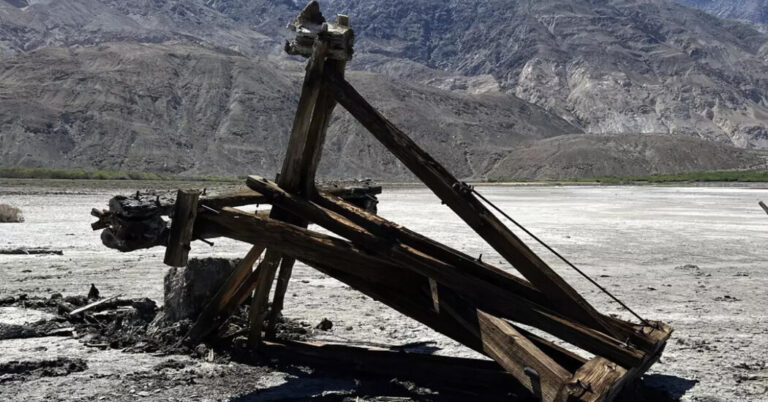A century ago, the timber-and-iron tower supported a tram carrying precious salt across the Inyo Mountains that was mined from a remote valley in the California desert. More recently, it stands as an artifact in the Saline Valley, and it marks the edge of a hiking trail through the sun-baked wilderness.
But a visitor to Death Valley National Park in California the 113-year-old structure was taken down on April 19 when it was used to try to pull a pickup truck out of the mud, prompting the National Park Service to investigate who was responsible for the damage.
The service’s request for information from the public elicited dozens of calls and messages, a video uploaded to YouTubeand finally a confession.
A park visitor said the damage was “done in a moment of desperation while stuck deep in the mud” and took full responsibility, according to a Park Service update issued Thursday.
A video of the incidentpublished by Outside magazine, showed a white pickup truck, partially submerged in mud, its wheels spinning in place.
The man, who has not been publicly identified by the Park Service, used the tower as an anchor to try to pull the pickup out of the mud. Slightly deteriorated from decades of exposure to extreme high temperatures and salt water, the tower collapsed, removing its concrete footing from the desert floor.
The video shows the pickup eventually being removed, apparently by winching it onto another vehicle.
The 200 square miles of salt flats around Badwater Basin in Death Valley National Park, which straddles the border along eastern California and southwestern Nevada, are too harsh an environment for most plants and animalsbut also quite fragile, consisting of fine crystals that are easily crushed underfoot.
The fallen tower, among four remaining of the original 20 built to support the tramway, is in poor condition due to periodic flooding from a nearby salt lake, according to a Park Service review from October 2021.
It formed part of a 13-mile aerial tram, built by the Saline Valley Salt Company in 1911, to transport salt from Saline Valley over the Inyo Mountains to Owens Valley.
“I’ve walked parts of this tramway, and I’m amazed at the perseverance it took to build it,” Mike Reynolds, superintendent of Death Valley National Park, said in a statement about the tower collapse.
Considered an engineering feat, the tramway climbed more than 7,000 feet on vertical grades of up to 40 degrees — at the time, the steepest angle of any tram system in the United States, according to the Park Service.
To build it, horses were used to transport a million board feet of lumber and 600 tons of steel “over rough, inaccessible, precipitous mountain country,” said the Park Service in a 1974 nomination to the National Register of Historic Places. The project bankrupted the Saline Valley Salt Company.
The tramway ceased operation in 1930. In 1974, when the Park Service nominated it for inclusion on the National Register of Historic Places, most of the building materials were “cart off,” according to the nomination form.
“However, many of the towers still remain, some with steel buckets still clinging to their sturdy cables high in the deep canyons,” the Park Service said.
The service said a “stabilization project” for the four towers, to be paid for through the Inflation Reduction Act, was planned before the tower was taken down. It is unclear whether those funds will be available to re-anchor the tower.
The Park Service said it was conducting a damage assessment, and “making plans for what responsible restoration of the salt tram would look like.”
